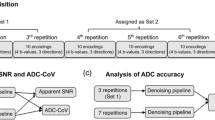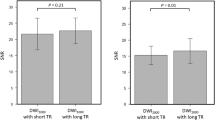Abstract
Objectives
The purpose of our study was to evaluate the use of 2D-selective, parallel-transmit excitation magnetic resonance imaging (MRI) for diffusion-weighted echo-planar imaging (pTX-EPI) of the prostate, and to compare it to conventional, single-shot EPI (c-EPI).
Methods
The MRI examinations of 35 patients were evaluated in this prospective study. PTX-EPI was performed with a TX-acceleration factor of 1.7 and a field of view (FOV) of 150 × 90 mm2, whereas c-EPI used a full FOV of 380 × 297 mm2. Two readers evaluated three different aspects of image quality on 5-point Likert scales. To quantify distortion artefacts, maximum diameters and prostate volume were determined for both techniques and compared to T2-weighted imaging.
Results
The zoomed pTX-EPI was superior to c-EPI with respect to overall image quality (3.39 ± 0.62 vs 2.45 ± 0.67) and anatomic differentiability (3.29 ± 0.65 vs 2.41 ± 0.65), each with p < 0.0001. Artefacts were significantly less severe in pTX-EPI (0.93 ± 0.73 vs 1.49 ± 1.08), p < 0.001. The quantitative analysis yielded a higher agreement of pTX-EPI with T2-weighted imaging than c-EPI with respect to coronal (ICCs: 0.95 vs 0.93) and sagittal (0.86 vs 0.73) diameters as well as prostate volume (0.94 vs 0.92). Apparent diffusion coefficient (ADC) values did not differ significantly between the two techniques (p > 0.05).
Conclusions
Zoomed pTX-EPI leads to substantial improvements in diffusion-weighted imaging (DWI) of the prostate with respect to different aspects of image quality and severity of artefacts.
Key Points
• Recent technical developments in MRI allow the use of accelerated, spatially-selective excitation (parallel-transmit, pTX)
• pTX can be used for zoomed echo-planar prostate imaging (pTX-EPI)
• pTX-EPI improves different aspects of image quality in prostate MRI
• Distortion artefacts are reduced by the use of pTX-EPI in prostate MRI
• Further studies should aim at assessing the diagnostic accuracy of pTX-EPI




Similar content being viewed by others
Abbreviations
- ADC:
-
Apparent diffusion coefficient
- BPH:
-
Benign prostatic hyperplasia
- c-EPI:
-
Conventional EPI (full field of view)
- DWI:
-
Diffusion-weighted imaging
- EPI:
-
Echo-planar imaging
- ETL:
-
Echo train length
- FOV:
-
Field of view
- ICC:
-
Intraclass correlation coefficient
- PSA:
-
Prostate-specific antigen
- ROI:
-
Region of interest
- pTX:
-
Parallel-transmit
- pTX-EPI:
-
Echo-planar imaging using parallel transmission technology
- TSE:
-
Turbo-spin-echo
References
Barentsz JO, Richenberg J, Clements R et al (2012) ESUR prostate MR guidelines 2012. Eur Radiol 22:746–757
Cornelis F, Rigou G, Le Bras Y et al (2013) Real-time contrast-enhanced transrectal US-guided prostate biopsy: diagnostic accuracy in men with previously negative biopsy results and positive MR imaging findings. Radiology 269:159–166
Delongchamps NB, Rouanne M, Flam T et al (2011) Multiparametric magnetic resonance imaging for the detection and localization of prostate cancer: combination of T2-weighted, dynamic contrast-enhanced and diffusion-weighted imaging. BJU Int 107:1411–1418
Franiel T, Hamm B, Hricak H (2011) Dynamic contrast-enhanced magnetic resonance imaging and pharmacokinetic models in prostate cancer. Eur Radiol 21:616–626
Giles SL, Morgan VA, Riches SF, Thomas K, Parker C, deSouza NM (2011) Apparent diffusion coefficient as a predictive biomarker of prostate cancer progression: value of fast and slow diffusion components. AJR Am J Roentgenol 196:586–591
Haider MA, van der Kwast TH, Tanguay J et al (2007) Combined T2-weighted and diffusion-weighted MRI for localization of prostate cancer. AJR Am J Roentgenol 189:323–328
Hambrock T, Somford DM, Huisman HJ et al (2011) Relationship between apparent diffusion coefficients at 3.0-T MR imaging and Gleason grade in peripheral zone prostate cancer. Radiology 259:453–461
Hoeks CM, Somford DM, van Oort IM et al (2013) Value of 3-T Multiparametric Magnetic Resonance Imaging and Magnetic Resonance-Guided Biopsy for Early Risk Restratification in Active Surveillance of Low-Risk Prostate Cancer: A Prospective Multicenter Cohort Study. Investig Radiol. doi:10.1097/RLI.0000000000000008
Kim CK, Park BK, Park W, Kim SS (2010) Prostate MR imaging at 3 T using a phased-arrayed coil in predicting locally recurrent prostate cancer after radiation therapy: preliminary experience. Abdom Imaging 35:246–252
Kim CK, Park BK, Kim B (2010) Diffusion-weighted MRI at 3 T for the evaluation of prostate cancer. AJR Am J Roentgenol 194:1461–1469
Kim CK, Park BK, Lee HM (2009) Prediction of locally recurrent prostate cancer after radiation therapy: incremental value of 3 T diffusion-weighted MRI. J Magn Reson Imaging : JMRI 29:391–397
Murtz P, Kaschner M, Traber F et al (2012) Diffusion-weighted whole-body MRI with background body signal suppression: technical improvements at 3.0 T. J Magn Reson Imaging : JMRI 35:456–461
Murtz P, Kaschner M, Traber F et al (2012) Evaluation of dual-source parallel RF excitation for diffusion-weighted whole-body MR imaging with background body signal suppression at 3.0 T. Eur J Radiol 81:3614–3623
Reischauer C, Wilm BJ, Froehlich JM et al (2011) High-resolution diffusion tensor imaging of prostate cancer using a reduced FOV technique. Eur J Radiol 80:e34–e41
Ren J, Huan Y, Wang H et al (2009) Seminal vesicle invasion in prostate cancer: prediction with combined T2-weighted and diffusion-weighted MR imaging. Eur Radiol 19:2481–2486
Rieseberg S, Frahm J, Finsterbusch J (2002) Two-dimensional spatially-selective RF excitation pulses in echo-planar imaging. Magn Reson Med: Off J Soc Magn Reson Med / Soc Magn Reson Med 47:1186–1193
Rosenkrantz AB, Kim S, Lim RP et al (2013) Prostate cancer localization using multiparametric MR imaging: comparison of Prostate Imaging Reporting and Data System (PI-RADS) and Likert scales. Radiology 269:482–492
Selnaes KM, Heerschap A, Jensen LR et al (2012) Peripheral zone prostate cancer localization by multiparametric magnetic resonance at 3 T: unbiased cancer identification by matching to histopathology. Investig Radiol 47:624–633
Somford DM, Hoeks CM, Hulsbergen-van de Kaa CA et al (2013) Evaluation of diffusion-weighted MR imaging at inclusion in an active surveillance protocol for low-risk prostate cancer. Investig Radiol 48:152–157
Tanimoto A, Nakashima J, Kohno H, Shinmoto H, Kuribayashi S (2007) Prostate cancer screening: the clinical value of diffusion-weighted imaging and dynamic MR imaging in combination with T2-weighted imaging. J Mag Reson imaging : JMRI 25:146–152
Thierfelder KM, Sommer WH, Baumann AB et al (2013) Whole-brain CT perfusion: reliability and reproducibility of volumetric perfusion deficit assessment in patients with acute ischemic stroke. Neuroradiology 55:827–835
Turkbey B, Merino MJ, Gallardo EC et al (2013) Comparison of endorectal coil and nonendorectal coil T2W and diffusion-weighted MRI at 3 Tesla for localizing prostate cancer: Correlation with whole-mount histopathology. J Mag Reson Imaging : JMRI. doi:10.1002/jmri.24317
Ueno Y, Takahashi S, Kitajima K et al (2013) Computed diffusion-weighted imaging using 3-T magnetic resonance imaging for prostate cancer diagnosis. Eur Radiol 23:3509–3516
Willinek WA, Gieseke J, Kukuk GM et al (2010) Dual-source parallel radiofrequency excitation body MR imaging compared with standard MR imaging at 3.0 T: initial clinical experience. Radiology 256:966–975
Yoshizako T, Wada A, Hayashi T et al (2008) Usefulness of diffusion-weighted imaging and dynamic contrast-enhanced magnetic resonance imaging in the diagnosis of prostate transition-zone cancer. Acta Radiol 49:1207–1213
Acknowledgments
The scientific guarantor of this publication is Kolja M. Thierfelder. The authors of this manuscript declare no relationships with any companies whose products or services may be related to the subject matter of the article. The authors state that this work has not received any funding. No complex statistical methods were necessary for this paper. Institutional Review Board approval was obtained. Written informed consent was obtained from all subjects (patients) in this study. Methodology: prospective, diagnostic study, performed at one institution.
Author information
Authors and Affiliations
Corresponding author
Rights and permissions
About this article
Cite this article
Thierfelder, K.M., Scherr, M.K., Notohamiprodjo, M. et al. Diffusion-weighted MRI of the Prostate: Advantages of Zoomed EPI with Parallel-transmit-accelerated 2D-selective Excitation Imaging. Eur Radiol 24, 3233–3241 (2014). https://doi.org/10.1007/s00330-014-3347-y
Received:
Revised:
Accepted:
Published:
Issue Date:
DOI: https://doi.org/10.1007/s00330-014-3347-y




